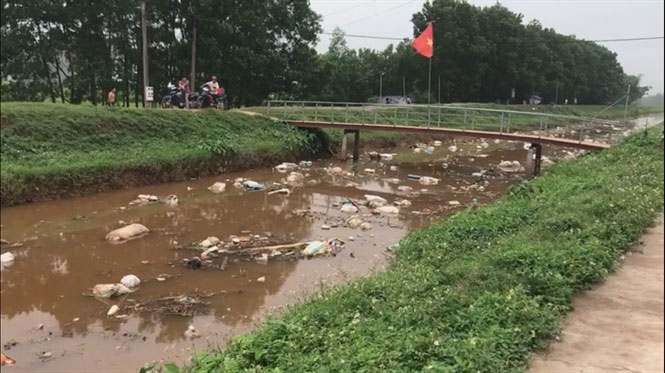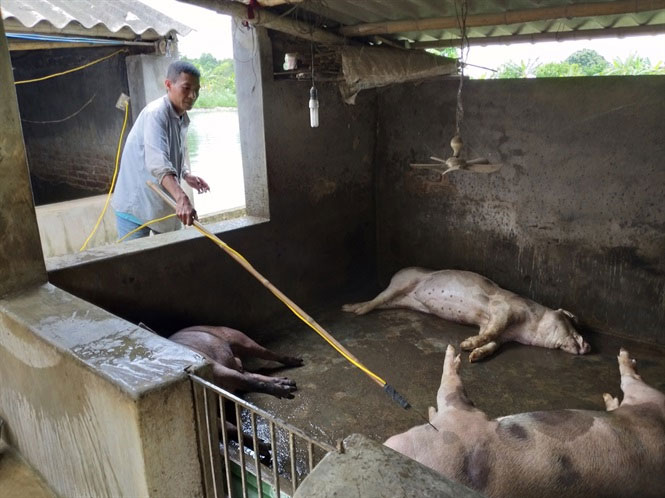Process of handling dead pigs due to disease
According to the process, when pigs are found dead or signs of disease, farmers are responsible for notifying commune veterinary staff or members of the Steering Committee for commune-level animal disease prevention and control to veterinarians. The district took the test to see if it was positive for African swine cholera as a basis for statistics and to destroy support later. Besides, depending on the size and level of the outbreak, there are measures to disinfect, disinfect, clean and set appropriate latches.
However, at present, due to too many epidemics, some localities have passed the testing stage if they realize that the manifestation of pigs died from cholera of Africa is too obvious for the destruction to be quickly and promptly avoided. Pigs die long and cause pollution and the risk of spreading disease.
The destruction of pigs and pig products of African pig cholera is mandatory and must be carried out properly, because the African swine virus has a high resistance, is able to withstand low temperatures, the virus has can survive in feces, blood, excretion, bone meat, and pigs for weeks to months, even a study in Belgium showed that African swine cholera virus exists in dead pig carcasses for up to 6 months.

Absolutely not throw the pig body into rivers and streams or lakes and ponds.
Therefore, people raising livestock because of themselves, relatives, neighbors and communities are absolutely forbidden to throw dead pig carcasses into rivers, streams, ponds, lakes, canals and rivers because then control cholera epidemic Africa will be many times harder.
The principle of destroying African cholera pigs
First, when a pig positive for African swine flu is identified, it is necessary to conduct an animal killing with electricity or another method.

Pigs before being destroyed need to be killed.
The location of destruction must be in accordance with the guidelines of the competent state authority, according to the recommendation of OIE and FAO, the priority should be given to the disposal site at the breeding area with infected animals or other suitable places near areas with outbreaks to limit the transport of pigs far away, causing viruses to spread to the environment affecting other safe breeding areas.
Destruction measures
Vehicles and tools used to transport by-products and other products to the destruction site must have a closed floor so as not to drop blood and pig wastes during the transportation process. Must be disinfected and disinfected before and after transporting to the destruction site, people involved in the process of destroying sick pigs, suspected pigs need to perform hygiene and disinfection to avoid spreading germs sick.
Currently, it is recommended that two main measures of disposal are burial and burning, but most of the localities choose to bury it because it is expensive to burn without burning a specialized furnace.
In case the destruction place is outside the area with an outbreak, animal carcasses, animal products must be put into bags, tightly sealed and concentrated into a place to spray disinfection before being transported. In case large animals do not fit in, they must use plastic sheets or other waterproofing materials to lining the inside (bottom and surrounding) of the transport means.
But the reality of this regulation is almost completely non-adherent to localities so it is also a cause of disease spread and spread more strongly.

Buried pig is the most popular destruction measure today.
Specification of burial pits
The recommended burial site location must be at least 30m from the house, water well, water source of the animal shed and has enough area, so choose a place to be buried in the garden (preferably fruit orchards or timber). The size of the burial pit must be large enough to suit the volume of animals, animal products and wastes to be buried, as prescribed from 1.5 to 3 meters deep.
Burial steps
Buried at the place where the epidemic occurred
This is a preferred option because of the limitation of spreading pathogens, in accordance with the regulations in disease prevention and epidemic control, and easy application of disinfection measures. However, it is only suitable for the volume of destruction not too large; Farms far from residential areas and large land.
The distance from the burial pit to water wells, stables and houses of workers: The volume of burial substances 50m; The volume of buried matter is 5-10 tons / pit, the minimum distance is> 100m.
- The number of pigs / pits does not exceed 5 tons / hole.
- Do not bury in flooded areas, with low water tables.

Need to bury properly when carrying pigs.
Buried pigs in the planned area
- In the event of a pandemic, large numbers of pigs cannot be buried at the place where the outbreak occurs.
- The transport of the pig body to the disposal site is in a car with a closed bottom, covered with polyethylene sheets on the roof. Do not overfill in the bin. Trucks must travel slowly to avoid spillage of pollutants.
- Escort staff must have protection and bring disinfectant disinfectants, necessary tools to disinfect spillage substances along the way. All trucks must be cleaned and disinfected before leaving the infected area and after unloading;
- To select areas far from population areas, at the foot of hills, mountains and areas planted with timber trees and perennial trees.
Managing burial pits
Animal burial compartments must have warning signs for people entering and leaving the area. Commune People's Committees are responsible for managing and organizing periodic inspections and timely handling incidents of landslides, subsidence, erosion, leakage and smell of burial pits. The burial sites must be marked on the commune maps, recorded and kept at the commune-level People's Committees. In case of hiring other organizations and individuals to carry out the destruction, the local veterinary management agencies shall organize the supervision of the implementation, ensuring the technical compliance according to regulations.
In particular, farmers are only allowed to re-breed pigs when having the consent and recommendations of the local veterinary and functional agencies, absolutely not allowed to raise pigs without the guidance of veterinarians. to avoid outbreaks of disease again.
- 3,000 pigs died drifting in Shanghai
- The process of washing corpses in Venezuela
- The process of collecting fish dies due to algal blooms in Florida
- Discover new methods to help pigs become immune to disease
- China deals with blue ear disease in pigs
- Misunderstandings about pigs that people have
- Discover the process of cremation of the dead
- Trial of treating cystic fibrosis on ... pigs
- Pigs are smarter than dogs and chimpanzees?
- China: Thousands of pigs died, the disease is unknown
- Pigs have fur like sheep
- Techniques of raising pure boar
 'Barefoot engineer' invents a pipeless pump
'Barefoot engineer' invents a pipeless pump Radiometer
Radiometer Warp Engine: Technology brings us closer to the speed of light
Warp Engine: Technology brings us closer to the speed of light Israel's advanced irrigation method has turned arid desert into a place to grow vegetables and fish
Israel's advanced irrigation method has turned arid desert into a place to grow vegetables and fish